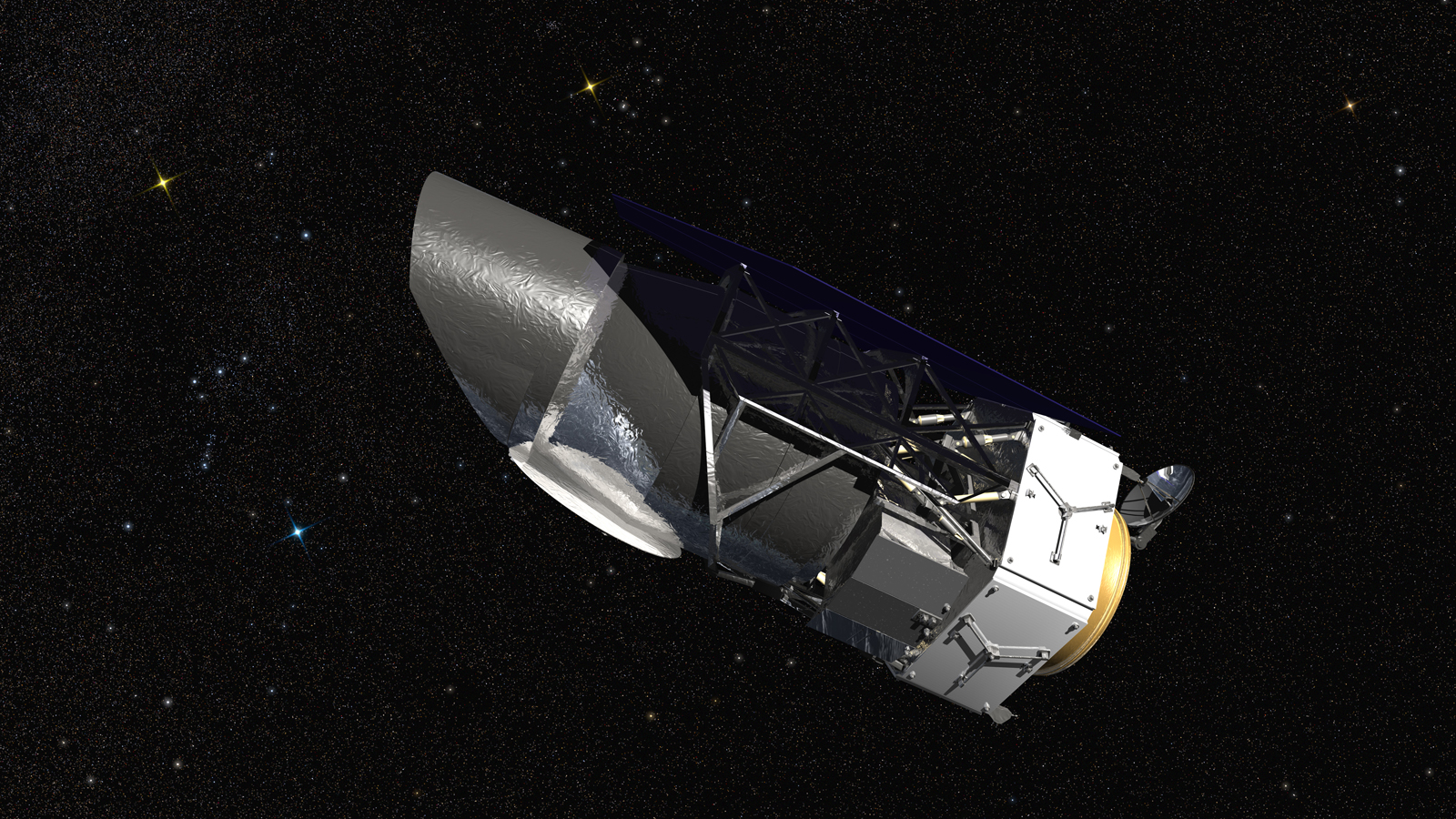
With construction of the James Webb Space Telescope rapidly moving forward at NASA’s Goddard Space Flight Center in Greenbelt, Md., for its upcoming launch in October 2018, excitement is steadily mounting among astronomers and space enthusiasts alike for what will undoubtedly be the launch of the decade in regards to astrophysics and cosmology—one that is expected to revolutionize both fields akin to the launch of James Webb’s scientific predecessor the Hubble Space Telescope, a quarter of a century ago. Despite this well-deserved anticipation, even more exciting times for space sciences lie ahead, with NASA having already started pre-formulation, preparatory studies in recent years for the next big astrophysics mission that will follow on the heels of the James Webb Space Telescope. This latest project, better known as the Wide-Field Infrared Survey Telescope, or WFIRST, has been officially given the go-ahead by the space agency earlier this month for a launch targeted in the early 2020s.
Among the many important discoveries that have taken place in astronomy and astrophysics in the last two decades, the discovery of a large diversity of exoplanets around other stars in our galaxy and the existence of dark energy can be considered the most ground-breaking and revolutionary. Building on the hugely successful legacy of NASA’s Great Observatories program, which consisted of the Hubble and Spitzer Space Telescopes, as well as the Compton Gamma Ray and Chandra X-ray Observatories, the National Research Council’s 2001 Decadal Survey in Astronomy and Astrophysics identified the determination of the Universe’s mass-energy content (including dark matter and dark energy), as well as its large-scale distribution across cosmic time and space, as one of its top science priorities. The mission that came on top on the 2001 Decadal Survey’s list for that matter was the Next Generation Space Telescope, that came to be known as the James Webb Space Telescope, which is now on its final stages of construction and assembly ahead of its launch on top of an Ariane 5 rocket in 2018.
Determining the exact nature of dark energy, which is a completely unknown form of energy that is believed to permeate the entire Universe that forces the latter’s expansion to accelerate over time, and searching for the first stars and galaxies that ignited in the primordial Universe, and which led to the large-scale structure that we see today, were some of the overriding themes for the 2010 Decadal Survey in Astrophysics. Yet, even though the James Webb Space Telescope is poised among other things to make significant contributions to the search of cosmic dawn in the primordial Universe, a better understanding of the mystifying dark energy would best be achieved by a space-based observatory that would have a very wide field of view, much bigger than that of Hubble and the James Webb telescopes.
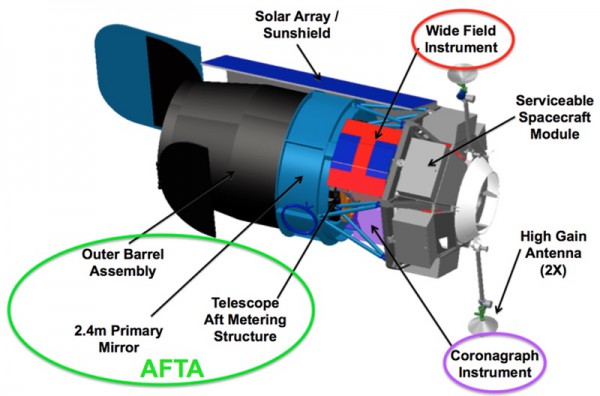
Enter the Wide-Field Infrared Survey Telescope, or WFIRST. Originally conceived in 2011, WFIRST was the offspring of a series of previous concept studies that were undertaken by both NASA and the U.S. Department of Energy for a project called the Joint Dark Energy Mission, which was envisioned as a large-aperture space telescope that would operate in optical and near-infrared wavelengths, with the goal of measuring how the expansion of the Universe has changed over time. When the National Research Council finally selected WFIRST instead of the Joint Dark Energy Mission as a better-suited mission to meet the science objectives of the 2010 Astrophysics Decadal Survey, the mission’s concept originally consisted of a 1.5-m near-infrared telescope. Yet, as luck would have it, around the same time the National Reconnaissance Office had two Hubble-sized 2.4-m telescopes on its hands that were no longer needed for their original intended use on classified reconnaissance satellites. This fortuitous turn of events meant that NASA could make a better use of these two surplus mirrors for its own space science needs. Then, on June 2012 the space agency announced much to the pleasant surprise of the astronomical community that these two Hubble-quality optics had indeed been transferred from NRO and were up for grabs to potentially be used for all sorts of astrophysics and planetary science missions.
Following a call for proposals from all interested parties in the months that followed, NASA finally selected WFIRST from the pool of submitted mission concepts in June 2013, as the beneficiary of one of the two donated telescopes. But due to the agency’s ever-present budgetary constrains, the official selection of the WFIRST mission for further implementation would have to wait until after the $8.8-billion James Webb telescope had left its peak development funding behind it—a milestone that would only be met in 2015, which meant that NASA could green-light WFIRST no sooner than 2017. That date, however, was ultimately moved to the left thanks to a stable funding that was provided by Congress in recent years, which was significantly higher than what NASA had originally requested for WFIRST. Furthermore, the final FY2016 Appropriations Bill that was passed by Congress last December also dictated NASA to go ahead with the mission in early 2016. In compliance, the space agency announced earlier this month that its Program Management Council had moved WFIRST forward from the conceptual study phase toward formulation (Phase A).
The announcement’s importance rests not only on the fact that it officially signifies WFIRST as the next big astrophysics mission for the next decade following the launch of the James Webb Space Telescope, but because it is also the next great step forward for cosmology and astrophysics as a whole. The use of the bigger 2.4-m optics that were donated from NRO greatly expanded the science scope of WFIRST, opening up exciting new possibilities for unprecedented astrophysical research in a wide range of fields, including exoplanets and protoplanetary disks, the study of star clusters and stellar streams in the Milky Way galaxy, as well as the study of our galaxy’s overall structure just to name a few. Thus, WFIRST’s main science goals, which has been renamed to WFIRST-AFTA (short for Astrophysics-Focused Telescope Assets) as defined in the mission’s final Science Definition team report, have been expanded to include the following:
• Probe the origin and destiny of our Universe,
including the nature of black holes, dark energy,
dark matter, and gravity
• Explore the origin and evolution of the galaxies,
stars, and planets that make up our Universe
• Discover and study planets around other stars,
and explore whether they could harbor life
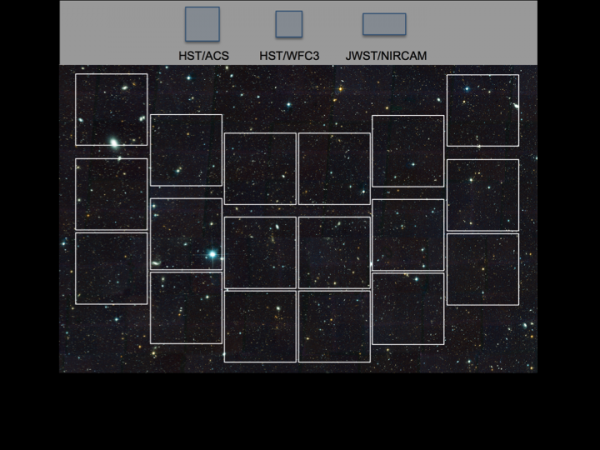
To that end, WFIRST will be equipped with two science instruments: a Wide Field Instrument, or WFI, that will operate in near- and mid-infrared wavelengths between 0.7 and 2 microns and a Coronagraph Instrument, or CGI, that will be sensitive in optical and near-infrared wavelengths between 0.4 and 1 micron. Even though the telescope’s primary mirror is the same size as Hubble’s, the similarities end there. Due to the technological advancements that have taken place since the construction of the Hubble space telescope in the late 1970s, WFIRST has a much shorter focal ratio (f/7.9) than its predecessor and a total of 18 infrared detectors for its WFI instrument—each with a resolution of 4096 x 4096 pixels, contrary to the single infrared detector of 1024 x 1024 pixels that is found on Hubble’s Wide Field Camera 3. These differences will give WFIRST a wide field of view that will be 100 times greater than that of both Hubble and the James Webb telescope, allowing for a wide, panoramic view of the sky. “WFIRST-AFTA has 288 times as many pixels as Hubble’s WFC-3, and 210 times JWST’s NIRCam’s field of view,” writes the mission’s science definition team report. “Compared to [ESA’s] Euclid, WFIRST-AFTA has approximately 4 times the collecting area and about 2.5 times the near-IR angular resolution.”
Besides the search for dark matter and extra-galactic astrophysics, WFIRST’s superior observing capabilities are poised to make significant contributions to the search and characterisation of extrasolar planets. Whereas the Kepler space telescope has been more sensitive due to its mission design to transiting gas giant “hot-Jupiter”-type exoplanets that lay very close to their home stars, WFIRST will instead focus on the opposite part of the spectrum, conducting microlensing surveys to look for planets that are located much farther out from their host star at orbits bigger than 1 Astronomical Unit away (1 AU is equivalent to Earth’s distance from the Sun). As has been reported on previous AmericaSpace articles, microlensing has already been used successfully from ground- and space-based telescopes in exoplanetary research, allowing astronomers to discover more than 20 extrasolar worlds to date in wide orbits around their star and even free-floating, rogue planets that roam the interstellar void. Furthermore, WFIRST’s coronograph instrument will allow astronomers to image directly exoplanets as small as Neptune and will also be sensitive to planets with Earth-like masses, thus providing a more complete census of the diversity of extrasolar worlds that exists in the galaxy. “The exoplanet survey on WFIRST-AFTA is sensitive to planets from roughly the outer habitable zone outwards, including rocky planets with the mass of Earth up to the largest gas giant planets, and analogs of the ice giant planets in our Solar System,” writes the mission’s science definition team. “WFIRST has the potential to open our eyes to the wonders of the Universe, much the same way Hubble has,” associate administrator of NASA’s Science Mission Directorate in Washington, D.C.., John Grunsfeld said in a press release. “This mission uniquely combines the ability to discover and characterize planets beyond our own Solar System with the sensitivity and optics to look wide and deep into the Universe in a quest to unravel the mysteries of dark energy and dark matter.”
AmericaSpace had the chance to talk with Dr. Neil Gehrels, Project Scientist for WFIRST at NASA’s Goddard Space Flight Center, regarding the mission’s science objectives and what we can expect to find with this latest set of eyes into the Universe.
- Dr. Gehrels, I’d like to thank you for taking the time to answer our questions regarding WFIRST. The mission’s concept has been benefited by the use of a 2.4-m telescope that was donated to NASA by the National Reconnaissance Office in 2012. In what ways will these bigger optics advance WFIRST’s science objectives compared to the project’s original design?
The 2.4 telescope is the size of the Hubble Space Telescope and has the same precise imaging capability. It has a larger mirror (2.4m diameter) than originally planned for WFIRST (1.5m diameter) and is more sensitive and has better imaging. It is a beautiful telescope for WFIRST that will allow seeing galaxies at larger distance and with better precision.
- With the trend among the astronomy community being towards building ever bigger ground and space-based telescopes, why the need for another Hubble-sized telescope in space?
This telescope will be used in a very different way than Hubble or ground telescopes. It will have a large-format camera with 400 million infrared pixels at the focal plane. This will provide image over 100 times larger area of sky (field of view) than HST.
- One of the main science objectives for WFIRST is the study of dark matter and dark energy, which are arguably two of cosmology’s contemporary greatest mysteries. How exactly will the telescope shed more light to these great cosmic unknowns?
WFIRST will survey large areas of the sky measuring the effects of dark matter on the distribution of galaxies in the universe. It will also observe distant Type Ia supernovae to use them as tracers of dark matter and dark energy. It will provide a huge step forward in our understanding of dark matter and dark energy. Briefly, the spacecraft will study dark matter and dark energy with several techniques. It will perform large surveys of galaxies and galaxy clusters to see the effects of dark matter and energy on their shapes and distributions in the Universe. All told, more than a billion galaxies will be observed by WFIRST. It will observe Type Ia supernovae to determine their distance and properties. More than 2000 supernovae will be observed. It will map out the acceleration of the Universe in distance to study the effects of dark energy and matter.
- The use of a 2.4-m telescope on WFIRST has allowed NASA to include a coronograph on the mission’s concept as well, which will allow for the direct imaging of distant exoplanets across the galaxy. What do we expect to see? Is the direct-imaging of Earth-sized exoplanets within reach?
The coronagraph is a high-tech exploratory instrument to take the first steps in direct imaging of exoplanets from space. We will target nearby stars and observe their exoplanets. The light from the planets will be observed by a spectrograph in the coronagraph to look for signatures of atmospheric chemistry and life. It will observe giant planets down to super-Earths, but not be sensitive enough to detect Earth-size exoplanets. That will be for the next generation of coronagraphs on future missions.
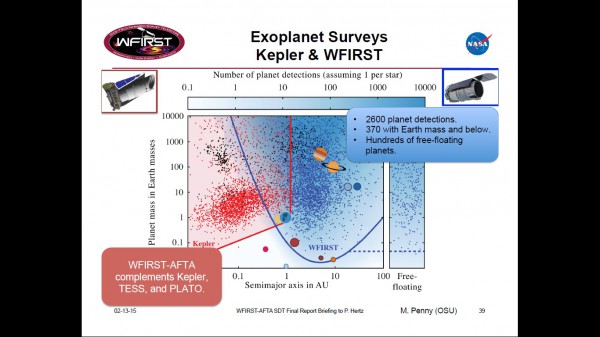
- The field of exoplanetary research in recent years has been dominated by the many revolutionary findings that have come from NASA’s Kepler space telescope, which is an exoplanet-dedicated mission. What new contributions will WFIRST bring in this field and how will it complement all the exciting discoveries that have already been made by Kepler to date?
WFIRST will perform a census of exoplanets at larger distances from their host stars, great than 1 astronomical unit, where Kepler is not sensitive. It will complement the Kepler survey. It will also directly image exoplanets with the coronagraph instrument.
- Another area where WFIRST is designed to provide valuable insights is in the field of astrometry and the study of the positions and motions of stars within the Milky Way galaxy, an area that is the main science goal of ESA’s Gaia mission. What will WFIRST’s contributions in this field be?
WFIRST’s primary science is not astrometry, but it will have remarkable capabilities. It will have much better astrometric precision than Gaia, but survey many fewer stars.
- Congress has provided a steady funding for WFIRST in recent years that has been above the levels that had been requested by NASA in its annual budget requests. How has this additional funding accelerated the mission’s schedule and what is the general roadmap from here on towards launch, construction-wise?
The funds provided by Congress and NASA in recent years have allowed for the technological advancement of the detector arrays and coronagraph. This has greatly reduced the risk of the mission. The roadmap toward launch is to perform a detailed design of WFIRST over the next 3 years, then build the observatory for following 5 years, then test and calibrate it for 1 year and launch in 2024 or 2025.
- Several major space-based telescopes like Hubble and the James Webb Space Telescope have been projects of international cooperation between space agencies across the world. Will WFIRST follow a similar path?
There are several countries and international space agencies interested in contributing to WFIRST. The WFIRST project team is currently working with these potential international partners to see what specific contributions can be made.
- Dr. Gehrels, besides being the Project Scientist for the WFIRST mission, you have been extensively involved in other major astrophysics missions in the last couple of decades as well, like INTEGRAL, Fermi, Swift and the Compton Gamma-Ray Observatory. How has the science of astrophysics evolved over this time and what are your hopes for the field’s future as well as the WFIRST mission in particular?
I have had the privilege of working for NASA on missions that performed the first comprehensive observations of the gamma-ray sky. We learned for the first time that sky is filled with objects such as black holes, supernovae and pulsars that emitted X-rays and gamma-rays. In some cases, like gamma-ray bursts, the radiation comes in bursts and flashes. I am now greatly looking forward to exploring the Universe in the infrared band with WFIRST.
Dr. Gehrels, I’d like to thank you once more for taking some off of your valuable time to talk with us!
With an estimated budget in the range of $2 billion, NASA’s Wide -Field Infrared Survey Telescope will be the next big thing in cosmology and astrophysics. WFIRST is currently scheduled to fly around the 2024 timeframe for a 6-year primary mission, and along with the James Webb space telescope which is expected to be well into its mission by that point, is poised to set up astronomers and space enthusiasts alike for a full decade of exciting discoveries in the 2020’s.
Video Credit: NASA/Goddard
Be sure to “Like” AmericaSpace on Facebook and follow us on Twitter: @AmericaSpace




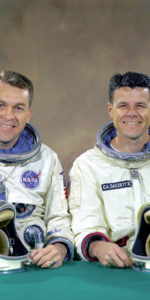
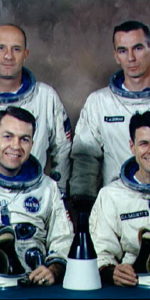
“All told, more than a billion galaxies will be observed by WFIRST….” That is incredible and yet still another testament to our insatiable curiosity about the cosmos. The discoveries yet to come will be amazing.
An interesting,informative and thought-provoking article, Leonidas. Thank you.
Great read! Exciting times ahead.